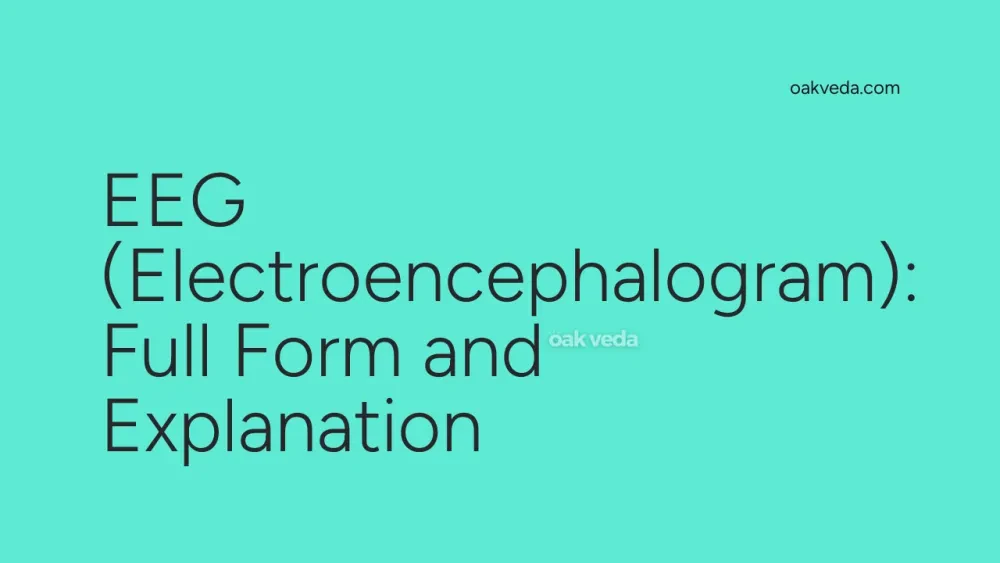
What is the Full Form of EEG?
The full form of EEG is Electroencephalogram. This medical procedure is widely used to evaluate and record the electrical activity of the brain, providing valuable insights into brain function and potential neurological disorders.
What is an Electroencephalogram?
An Electroencephalogram, commonly referred to as EEG, is a non-invasive diagnostic test that measures and records the electrical impulses produced by brain cells (neurons). This sophisticated procedure captures brain wave patterns, offering a real-time view of the brain's functioning over a specific period.
Origin and Development of Electroencephalogram
The history of EEG dates back to the late 19th century when scientists first discovered electrical activity in the brain. However, it wasn't until 1924 that German psychiatrist Hans Berger recorded the first human EEG. Since then, the technology has evolved significantly, becoming an indispensable tool in neurology and psychiatry.
How does an Electroencephalogram work?
The EEG procedure is a safe and painless process that involves the following steps:
- Electrode placement: Small metal discs with thin wires (electrodes) are attached to specific locations on the scalp using a special adhesive.
- Signal detection: These electrodes detect the electrical impulses generated by brain cells.
- Signal amplification: The detected signals are amplified and sent to a computer for processing.
- Recording: The computer translates these signals into a series of wavy lines, which are displayed on a monitor or printed on paper.
- Analysis: A neurologist or trained professional interprets these wave patterns to assess brain activity and identify any abnormalities.
Types of Electroencephalogram
There are several types of EEG tests, each serving specific diagnostic purposes:
- Routine EEG: A standard test lasting about 20-40 minutes, often used for initial evaluations.
- Ambulatory EEG: A portable EEG that records brain activity over 24-72 hours during normal daily activities.
- Video EEG: Combines EEG recording with video monitoring, useful for diagnosing epilepsy.
- Sleep EEG: Conducted during sleep to diagnose sleep disorders or nocturnal seizures.
- Invasive EEG: Involves placing electrodes directly on the brain surface, used in specific cases requiring more precise readings.
Functions of Electroencephalogram
The primary functions of an EEG include:
- Detecting abnormalities in brain electrical activity
- Diagnosing and monitoring seizure disorders, including epilepsy
- Evaluating sleep disorders
- Assessing brain function after head injuries or before organ transplants
- Monitoring brain activity during surgery
- Investigating changes in behavior or cognitive function
Applications of Electroencephalogram
EEG has a wide range of applications in medical and research fields:
- Neurology: Diagnosing and managing epilepsy, brain tumors, and other neurological disorders
- Psychiatry: Investigating conditions like depression, anxiety, and ADHD
- Sleep medicine: Studying sleep patterns and diagnosing sleep disorders
- Anesthesiology: Monitoring brain activity during surgery
- Research: Studying brain function, cognition, and behavior
- Brain-computer interfaces: Developing technologies to assist individuals with severe motor disabilities
Features of Electroencephalogram
Key features of EEG include:
- Non-invasive: Does not require any incisions or injections
- Real-time monitoring: Provides immediate information about brain activity
- High temporal resolution: Captures rapid changes in brain activity
- Cost-effective: Relatively inexpensive compared to other brain imaging techniques
- Versatile: Can be used in various settings, including clinics, hospitals, and research laboratories
Benefits of Electroencephalogram
EEG offers numerous benefits in healthcare and research:
- Early detection of neurological disorders
- Precise diagnosis of epilepsy and seizure disorders
- Monitoring of treatment effectiveness for various brain conditions
- Improved understanding of brain function and cognitive processes
- Assistance in surgical planning for certain neurological conditions
- Non-invasive nature makes it suitable for repeated use and long-term monitoring
Limitations or Challenges of Electroencephalogram
Despite its many advantages, EEG has some limitations:
- Limited spatial resolution compared to imaging techniques like MRI or CT scans
- Difficulty in detecting activity from deeper brain structures
- Susceptibility to artifacts from muscle movements or electrical interference
- Interpretation of EEG results requires specialized training and expertise
- May not detect all types of seizures or neurological abnormalities
Future Developments in Electroencephalogram Technology
The field of EEG is continuously evolving, with several exciting developments on the horizon:
- High-density EEG: Increasing the number of electrodes for more detailed brain mapping
- Dry electrode technology: Eliminating the need for conductive gel, making EEG more user-friendly
- Wireless and wearable EEG devices: Enabling long-term monitoring in natural environments
- Advanced signal processing: Improving artifact removal and data interpretation
- Integration with other imaging modalities: Combining EEG with fMRI or MEG for more comprehensive brain analysis
- AI and machine learning: Enhancing EEG data analysis and interpretation
FAQs on EEG Full Form
-
How long does an EEG test typically take? A routine EEG usually takes 20-40 minutes, while longer-term monitoring can last 24-72 hours or more.
-
Is an EEG test painful? No, EEG is a painless and non-invasive procedure.
-
Can EEG detect all types of seizures? While EEG is highly effective in detecting many types of seizures, some seizures may not be captured during a routine EEG.
-
How should I prepare for an EEG test? Your doctor will provide specific instructions, but generally, you should avoid caffeine and sleep medications before the test.
-
Can EEG diagnose mental health conditions? EEG can provide valuable information about brain function, but it's not typically used as the sole diagnostic tool for mental health conditions.
By understanding the full form and functions of EEG, we can appreciate its crucial role in modern neurology and brain research. As technology continues to advance, EEG remains an invaluable tool in unraveling the mysteries of the human brain.
You may be interested in:

